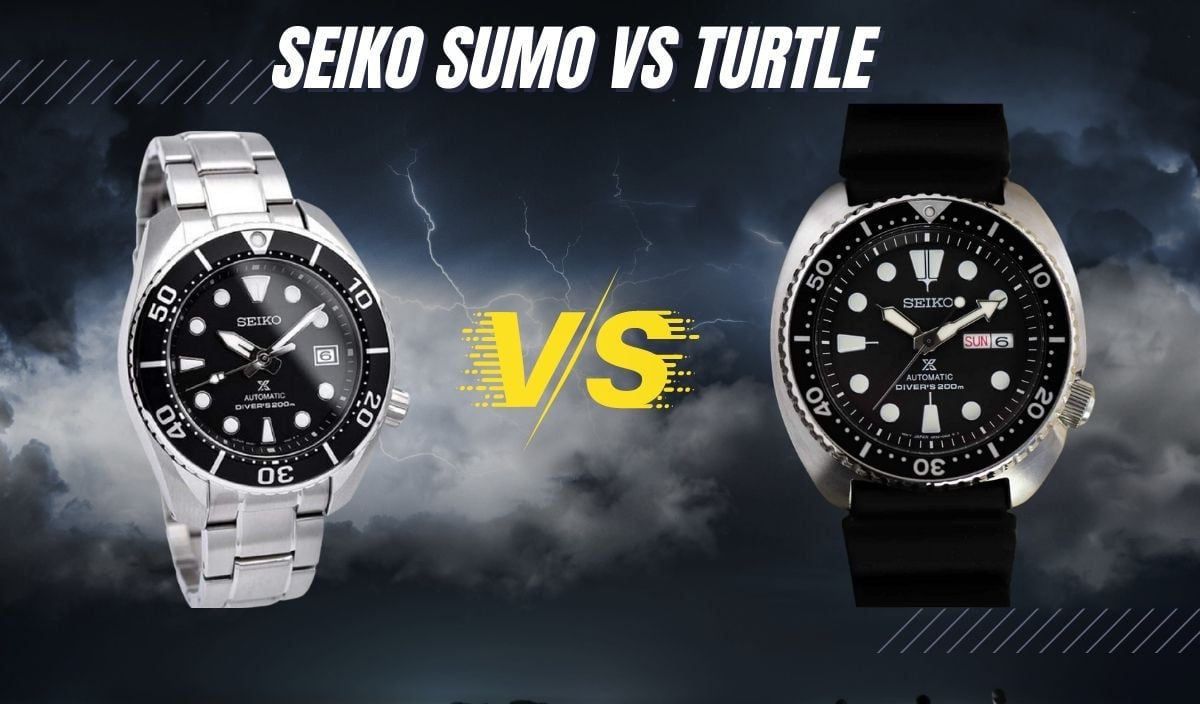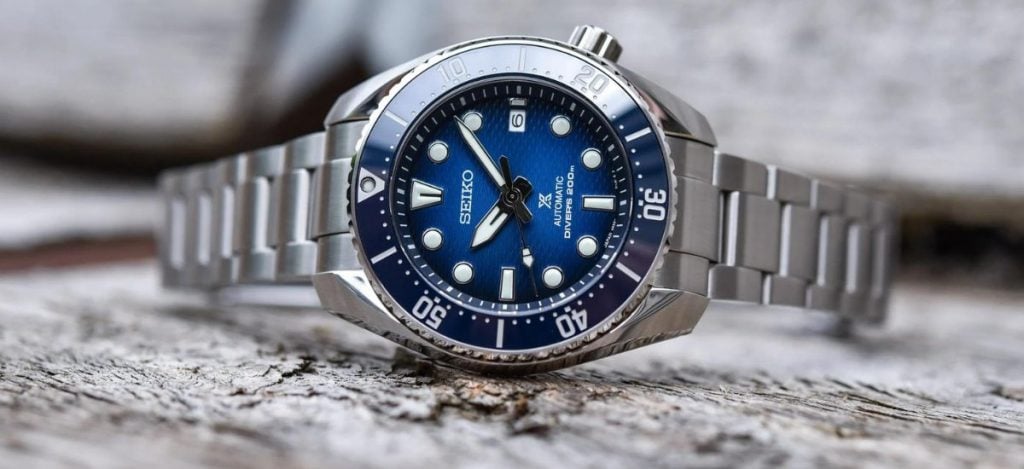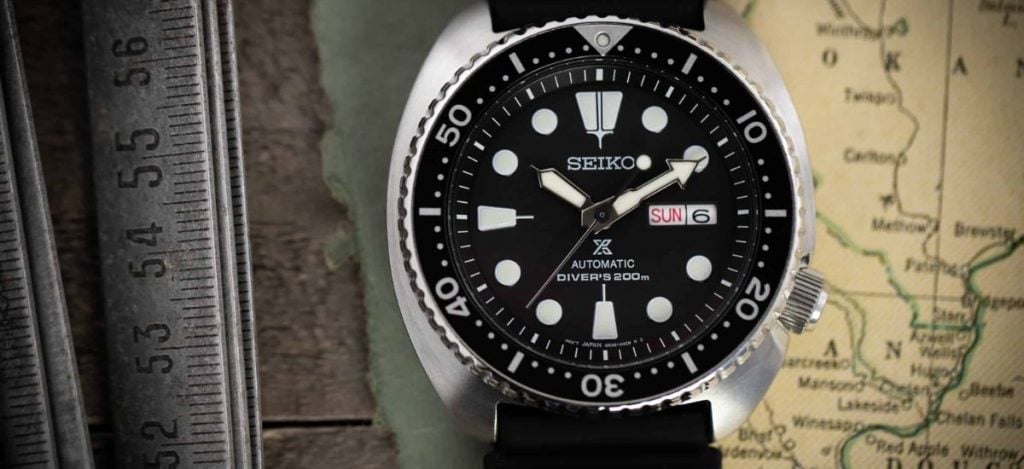
Seiko Sumo Vs. Seiko Turtle: The ONLY Comparison You Need
The Seiko Sumo and Turtle are two of the storied Japanese brand’s most popular dive watches. They’re both 200-meter divers within Seiko’s Prospex line that come with oversized cases and bulletproof movements.
Even among the throngs of Rolex Submariner acolytes, the Sumo and the Turtle gain much respect for their toughness and tool-watch street cred. Though both watches differ slightly in appearance, they offer similar value for money.
Nevertheless, the two have enough differences to merit a comparison for those trying to choose between them (why not get both?). We’ve done the research, so you don’t have to. Keep reading to see the similarities and differences between the Seiko Sumo and Seiko Turtle.
After all, when it comes to buying the right watch, knowledge is power. Plus, you might just learn a thing or two!
About the Seiko Sumo

The Seiko Sumo was introduced in 2007 as an ISO-rated dive watch for the masses. The Seiko Sumo is a serious dive watch for serious divers. The Sumo’s development resulted from saturation divers complaining that their timepieces would continually become damaged at great depths because they simply didn’t have the robust case construction to handle the immense pressure.
Seiko made developing this watch a serious mission, and in 2007, the watch was released to the public. Since that release, it has become one of the most popular dive watches in the world and one that most people can afford! Moreover, it’s almost instantly recognizable to anyone who’s a fan of dive watches.
About the Seiko Turtle

The “Turtle”, as the Seiko Prospex has come to be called by its fans, is quite a bit older than the Sumo. The original iteration of this watch was launched in 1976 (as was I, but that’s neither here nor there). When the watch was first released, the Turtle was a popular model.
However, as the legendary Seiko SKX models began to dominate the affordable diver market, Seiko ceased production of the Turtle for several years. But in 2016 (due in part to demand from the marketplace), collectors and divers were thrilled to hear that the Turtle would be making a return. Some said it was even more exciting than the return of the McRib!
Seiko Sumo Vs. Seiko Turtle: A Clash Between Two Dive Watch Titans
To offer the most thorough comparison of these two rugged divers, we’ve broken them down to some of their most important characteristics. We’ve compared and contrasted so that you get a good idea of what each watch offers and what it doesn’t.
While we understand that choosing a timepiece often comes down to the intangibles, it still helps to know what each watch brings to the table. Read through the following analysis, and you should clearly see which of these two watches is the right pick for your needs.
Case
Case size and shape are typically the first things you’ll notice about any watch. That being said, the Seiko Sumo and the Seiko Turtle have two of the most recognizable cases in the dive watch world. The Turtle may be more iconic due to its very original case design, which does, in fact, resemble a turtle shell.
However, it’s slightly less tall than the Sumo. Both watches are intentionally chunky in every direction, and if you disrespect either, they just may bodyslam you. Both pieces also offer a case size of 45mm, though the shapes differ slightly.
The Turtle has a more rounded and fluid design, while the Sumo’s angular lugs give it a more industrial tool watch look. Another similarity between the two watches is the unidirectional rotating dive bezel. Both have aluminum bezel inserts and offer a pleasing click when rotating the bezel.
Water Resistance
This is another area where the Turtle and the Sumo are equally robust. With solid screw-down crowns and case backs, each watch offers a solid water resistance of 200 meters. Moreover, you’re likely to get even more performance out of each piece than the stated 200 meters, though you’ll probably never have to test that theory yourself. Both watches have the crown around 4 o’clock, a welcome change for many divers from the standard 3 o’clock on most pieces.
Complications
When it comes to complications, the Sumo is available with a day date function, while the Turtle is only available with a date window. While this is likely not a deal breaker for anyone whose main concern is dive readiness, it’s still a consideration for some. Other than that, both watches are standard three-hand divers without many other bells and whistles.
Their toughness and durability are where they really earn their stripes. If you’re looking for a more complicated dive watch with extras like a helium escape valve or alarm function, you’ll probably want to look elsewhere. These two watches are no-nonsense workhorses that reflect their comfortable price points.
Hands
The handsets on both watches have quite different looks and feel. The Sumo has basic tapered hour and minute hands, while the stick second hand has a small marker toward the end. On the other hand, the Turtle has a plain stick hand seconds hand, a plunger hour hand, and a highly visible arrow hand for the minutes. Both handsets have a sporty feel and are easy to read, but some may find the Turtle’s hands a bit more interesting.
Movement
The Seiko Sumo houses the impressive Seiko 6R35 automatic movement, which boasts a semi-ridiculous power reserve of 70 hours. While the Sumo’s movement is quite a feat of engineering, the Turtle is no slouch itself. It uses another one of Seiko’s highly accurate and dependable automatic movements, the 4R36.
It has the same beat rate as the Sumo’s movement and only has a slightly shorter power reserve. What the 4R36 does have over the 6R35 is a day date function. If this is important to you, then you’ll probably want to opt for the versatile Turtle of the simpler and utilitarian Sumo.
Crystal
As with most standard Seiko divers, the Seiko Sumo and Seiko Turtle come with the brand’s proprietary Hardlex scratch-resistant crystal. Hardlex is made using a mixture of silicon and barium that is heated and combined before it cools and hardens.
According to Seiko, Hardlex is more scratch resistant than the standard mineral glass on most other affordable watches. While many watch collectors may prefer sapphire glass to Hardlex crystal, it’s still a decent step up from the standard mineral glass.
Strap/Bracelet
Both the Turtle and the Sumo come with standard Seiko 316L stainless steel bracelets. While these bracelets are fine for diving, many skilled divers prefer a rubber or nato strap. This is where the Turtle gains another slight advantage.
It has a rubber strap option available at purchase, which the Sumo does not. That said, you can always purchase a rubber strap afterwards for your Sumo, but doing so will be an additional cost and time requirement.
Price & Availability
Both the Seiko Sumo and Seiko Turtle are readily available online and in many stores as well. However, you can expect to pay quite different prices for each. The current models of the Seiko Turtle can be found for around $400.
Explore the
Biggest Pre-Owned Collection of Luxury Watches
The Sumo, on the other hand, will cost you a bit more. Most retailers sell the Seiko Sumo for about $700, making it more of an investment than the Turtle. These are prices for new watches. However, on the secondary market, you’re likely to find both at an even lower price, though they will be “previously loved”.
If you don’t mind getting a slightly used version of these watches, then you can probably get a great deal online.
Conclusion
Ultimately, which watch you choose will come down to personal preference. Some will prefer the aesthetics of one model over the other, while legibility and useability will be the determining factors for others.
The Seiko Turtle and the Seiko Sumo both offer the same basic value proposition. They’re incredibly durable dive watches that won’t have you worried if you get them scratched or beaten up. While not typically mentioned in many reviews of the Turtle and the Sumo, they also make for great-looking daily beaters, even if you never set foot in the water.
Dive watches are the most popular style for most men, so you can’t go wrong with either of these on your wrist in any environment, be it wet or dry. Before choosing between these two equally impressive watches, the most important thing to remember is to be fully informed.
Know what each timepiece offers and doesn’t, and use that knowledge to make a fully informed decision. If you do that, then you’re probably not going to be disappointed in your choice, no matter which route you take.
About Exquisite Timepieces
Established in 1998, Exquisite Timepieces is your one-stop shop for all things luxury watches! We are an authorized dealer for 60+ luxury watch brands including Omega, Hublot, Seiko, & Longines! We are proud to showcase one of the world’s largest pre-owned watch collections, including renowned brands like Rolex and Patek Philippe. Check out our brand new watch arrivals here and popular pre-owned listings here.



















